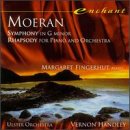| All Artists: Moeran, Fingerhut, Handley Title: Symphony in G Minor / Rhapsody in F Sharp Major Members Wishing: 1 Total Copies: 0 Label: Chandos Original Release Date: 1/1/2000 Re-Release Date: 1/19/1999 Genre: Classical Styles: Forms & Genres, Concertos, Historical Periods, Modern, 20th, & 21st Century, Instruments, Keyboard, Symphonies Number of Discs: 1 SwapaCD Credits: 1 UPC: 095115710623 |
Search - Moeran, Fingerhut, Handley :: Symphony in G Minor / Rhapsody in F Sharp Major
 | Moeran, Fingerhut, Handley Symphony in G Minor / Rhapsody in F Sharp Major Genre: Classical
|
Larger Image |
CD Details |
CD ReviewsShy Moeran at his best K. Farrington | Missegre, France | 04/10/2000 (5 out of 5 stars) "The composer Ernest Moeran was a pupil of john Ireland and was a friend and an exact contemporary of Phillip Heseltine (Peter Warlock), surviving him by 20 years. Like his friend, Moeran was interested in the musicology of the English Musican Renaissance which was so hot during the 1920's. Warlock looked at the glories of Tudor music whereas Moeran looked to folksong as a source of inspiration, being an expert collector himself in his native Norfolk. Moeran also was inspired by landscape, particularly by his Irish visits which crystallised his own Irish parentage. The omnipresent Sibelius is also here in this work with the low woodwind phrases as well as dark skittering strings in low ostinati. The melodies are folkish with Irish overtones and rich and luscious in their depiction of rural sensibilities. The noisy, rumbustuous village is there as well as the quiet, meditative, leafy wood. The Symphony (here) and the Violin Concerto (available on another Chandos CD) are considered to be Moeran's best works for the large canvas and Handley is just the man to put this across. He provides us with a work that is grim as well as pastoral and the cold shrill winds that blow through it are formidable. It is as if we are living in the eye of a hurricane with stormy tones amidst a beautiful summer's day. The work is big in scope and is as substantial as Bax's 6th, for example, a work with which it shares some atmosphere in its sublimated Sibelius. The Rhapsody for piano is altogether lighter but still magnificent and played with real aplomb by Fingerhut who seems to have cornered the market in Harriet Cohen numbers for Chandos. This CD is brilliant and is a real deal with a generous amount of wonderful tuneful music of a shy and underrated genius." An Important and Beautiful English Symphony Thomas F. Bertonneau | Oswego, NY United States | 10/09/2000 (4 out of 5 stars) "At the end of his foreshortened life (he died by drowning in the River Kenmare in 1950), Ernest John Moeran (born 1894) had begun work on a Second Symphony to follow up his First; he never completed it, alas, and the First (1937) thus stands alone. The G-Minor is in every way a major British (I'd call it an ENGLISH) symphony, showing some relation to Vaughan-Williams and Bax, and some (as Peter Pirie notes) to Sibelius, but distinctively enough in Moeran's own musical dialect not to be mistaken for anyone else's work. The First Movement (Allegro) begins with a big, galloping tune propelled by an ostinato and heard in the full orchestra - so memorable that it sticks in the mind after a single hearing; so does the delicate second subject, introduced by strings alone. The Second Movement comprises a Lento, full of the sense of the sea and with elements of a nocturne. Then comes a brief Scherzo (Vivace), followed by a long but dramatic Finale (Lento; Allegro Molto). The whole takes rather more than three quarters of an hour, but one's interest never flags. The best recorded performance is the earliest: Leslie Heward's with the Hallé Orchestra, made in the presence of Moeran in Manchester in 1942, just before Heward's death. Dutton reissues it (or did) in a reengineered version so breathtaking in its clarity and fullness of sound that one might easily mistake it for a modern recording. The weakest of the recordings is the early 1970s EMI one, with Neville Dilkes leading the English Sinfonia. The G-Minor needs a large orchestra and Dilkes' is a chamber-sized group. (Anyway, this item is probably "nla.") Sir Adrian Boult's traversal appeared on a Lyrita LP around the same time, but has (sadly) disappeared. The current major contender is still Vernon Handley, with the Ulster Orchestra, on Chandos, very brilliantly and convincingly played. Handley's Finale keeps the episodes together in a way which even Heward can't quite match, superb though he is. But Handley comes from 1988, more than a decade ago. Surely it's time for a new recorded performance of this endearing and important work."
|

 Track Listings (5) - Disc #1
Track Listings (5) - Disc #1